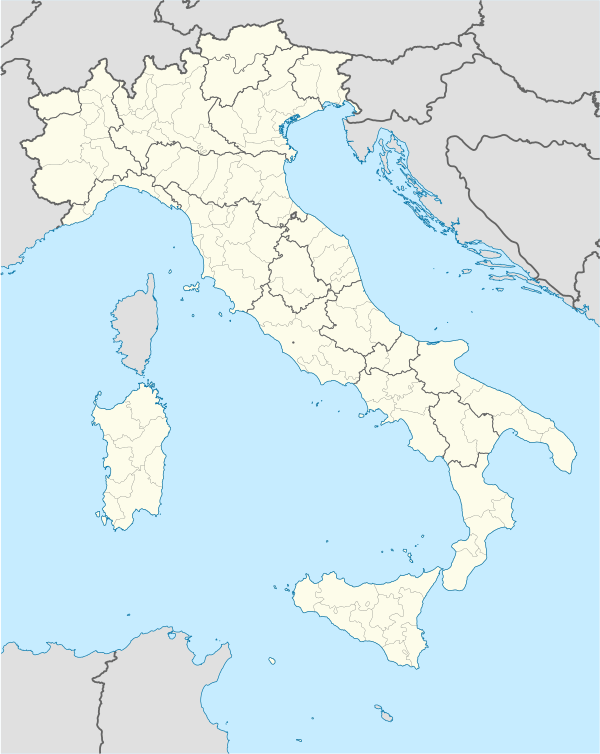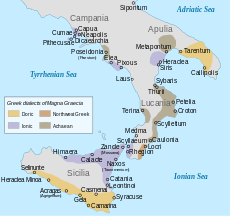Helorus
| Helorus | |
|---|---|
|
The archaeological site of Helorus | |
 Shown within Italy | |
| Location | Noto, Province of Syracuse, Sicily, Italy |
| Coordinates | 36°50′32″N 15°06′34″E / 36.84222°N 15.10944°ECoordinates: 36°50′32″N 15°06′34″E / 36.84222°N 15.10944°E |
| Satellite of | Syracuse |
| Site notes | |
| Management | Soprintendenza BB.CC.AA. di Siracusa |
| Public access | Yes |
| Website | Area Archeologica di Eloro (Italian) |
Helorus, Heloros, Helorum, or Elorus (Greek: Ἔλωρος or Ἕλωρος, Ptol., Steph. B. or Ἕλωρον, Scyl.; Italian: Eloro), was an ancient city of Sicily, situated near the east coast, about 40 km south of Syracuse and on the banks of the river of the same name.[1] It is currently an archaeological site in the modern comune of Noto.[2]
History
We have no account of its origin, but it was probably a colony of Syracuse, of which it appears to have continued always a dependency. The name is first found in Scylax;[3] for, though Thucydides repeatedly mentions the road leading to Helorus from Syracuse,[4] which was that followed by the Athenians in their disastrous retreat, he never speaks of the town itself. It was one of the cities which remained the under the government of Hieron II by the treaty concluded with him by the Romans, in 263 BCE:[5] and, having during the Second Punic War declared in favor of the Carthaginians, was recovered by Marcus Claudius Marcellus in 214 BCE.[6]
Under the Romans it appears to have been dependent on Syracuse, and had perhaps no separate municipal existence, though in a passage of Cicero[7] it appears to be noticed as a civitas. Its name is again mentioned by the orator (Id. v. 34) as a maritime town where the squadron fitted out by Verres was attacked by pirates: but it does not occur in Pliny's list of the towns of Sicily; though he elsewhere[8] mentions it as a castellum on the river of the same name: and Ptolemy[9] speaks of a city of Helorus.
Its ruins were still visible in the days of Fazello; a little to the north of the river Helorus, and about a mile from the sea-coast. The most conspicuous of them were the remains of a theatre, called by the country people Colisseo: but great part of the walls and other buildings could be traced. The extent of them was, however, inconsiderable. These are now said to have disappeared, but there still remains between this site and the sea a curious column or monument, built of large stones, rising on a square pedestal.
This is commonly regarded as a kind of trophy, erected by the Syracusans to commemorate their victory over the Athenians. But there is no foundation for this belief: had it been so designed, it would certainly have been erected on the banks of the river Asinarus, which the Athenians never succeeded in crossing.[10]
References
- ↑ Steph. B. s. v.; Vib. Seq. p. 11.
- ↑ Wilson, R., DARMC, R. Talbert, S. Gillies, T. Elliott, J. Becker. "Places: 462234 (Helorus)". Pleiades. Retrieved March 22, 2013.
- ↑ § 13. p. 168;
- ↑ τὴν Ἑλωρίνην ὁδόν, vi. 66, 70, vii. 80.
- ↑ Diodorus xxiii. Exc. H. p. 50, where the name is corruptly written Αἰλώρων.
- ↑ (Livy xxiv. 35.
- ↑ In Verrem iii. 48.
- ↑ xxxii. 2.
- ↑ iii. 4. § 15.
- ↑ Tommaso Fazello. iv. 2. p. 215; Cluverius Sicil. p. 186; William Henry Smyth, Sicily, p. 179; Richard Hoare, Classical Tour, vol ii. p. 136.
 This article incorporates text from a publication now in the public domain: Smith, William, ed. (1854–1857). "article name needed". Dictionary of Greek and Roman Geography. London: John Murray.
This article incorporates text from a publication now in the public domain: Smith, William, ed. (1854–1857). "article name needed". Dictionary of Greek and Roman Geography. London: John Murray.
External links
| Wikimedia Commons has media related to Eloro. |
- Official website (Italian)
| ||||||||||||||||


